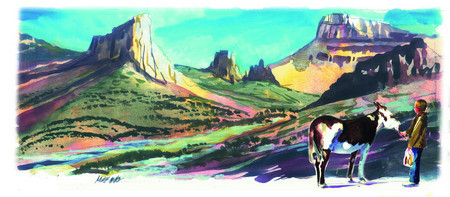Long past the golden days, Oatman thrives on tourism

In its gold mining heyday, Oatman, Ariz., claimed 10,000 residents and thousands of travelers passing through on Route 66, America’s “Mother Road.” Today, the ghost town thrives on tourism, with half a million people annually finding their way to this unusual town where wild desert burros begging for snacks have the right-of-way and gunslingers battle on the main drag several times a day.
To reach Oatman, follow U.S. 95 south to Highway 163, the road to Laughlin on the Nevada side of the Colorado River and Bullhead City on the Arizona side. Cross the river bridge at Laughlin. Two routes take you to Oatman: one longer, but completely paved, the other shorter and partially paved. For the paved route, turn south on the highway paralleling the river through Bullhead City. Drive 10 miles to Boundary Cone Road. Turn east 12 miles to reach Historic Route 66. Head north two miles to Oatman. The 15-mile partially paved route takes you east from Bullhead City on Silver Creek Road directly to Old Route 66 to Oatman.
Gold mining began with discoveries in 1898. Mining companies with investment capital soon bought up the original claims. The Vivian Mine operating near today’s Oatman gave the rising camp its original names. The camp later took the name of Oatman to honor a family heading west through Arizona in the mid-1800s that was attacked and massacred by Apaches in the mid-1800s.
The Apaches left one Oatman boy for dead and carried off two sisters. The younger brother recovered to begin a years-long search for the girls. Sold into slavery among one of the Colorado River tribes, only one girl survived. Young Olive Oatman lived to rejoin her brother, bearing to the end of her days the facial tattoos of the culture with which she lived.
Together with a neighboring camp called Goldroad, a little more than two miles north, Oatman developed into an early-20th century success that out-produced all other mining areas in Arizona, yielding many millions in gold. For a few years, the future seemed secure.
In the manner of mining boom towns, Oatman’s fortunes fluctuated. It hung on through increasingly lean years until World War II. The government decided other metals were more important to the war effort than gold. When the mines closed, the miners moved elsewhere. Within months, just a couple hundred people remained in the area. In Goldroad, owners razed the buildings rather than pay taxes on them, leaving just foundations and rusting castoffs. In the 1990s, gold production resumed in Goldroad, but shut down after a few years. Mine tours became popular until a couple of years ago when the rising price of gold made mining there feasible again.
Because of Route 66, Oatman survived the 1940s by serving travelers, though their numbers dropped with wartime rationing of gasoline, oil and rubber. After the war, the idea of an improved national highway system was born. When Dwight D. Eisenhower became president, it became a priority. The interstate system bypassed many highway-dependent communities, including Oatman. Old Route 66 over precipitous Sitgreaves Pass into Oatman became obsolete. Hard hit, Oatman all but disappeared in the 1960s.
Oatman soon began to benefit from ex-urbanites sick of city life and seeking out backwaters. These folks brought new life to tired places across the country. Buying or renting and rehabbing old buildings, they started businesses. They helped play up the history of such places. Oatman had the allure of the Old West and the nostalgia of Route 66 to its credit. Nearby Laughlin’s growth brought Oatman increased tourism.
Today, Oatman houses about 40 businesses in reproduction and original buildings. Don’t miss the two-story adobe Oatman Hotel with its first-floor restaurant and bar. Upstairs guest rooms once attracted celebrities such as film star couple Clark Gable and Carole Lombard. The rooms now house museum exhibits. The crowds along the streets today rival those in Oatman in her first flush years.
Margo Bartlett Pesek’s column appears on Sundays.












